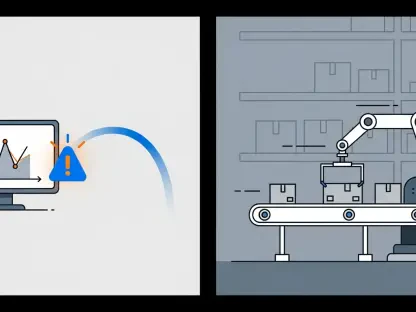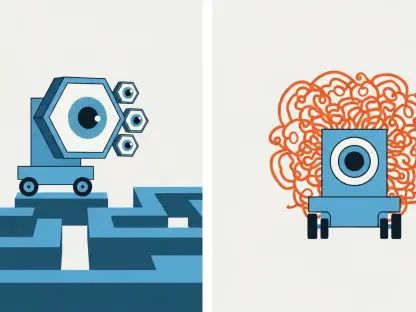In the dynamically evolving landscape of mobile technology, artificial intelligence (AI) has emerged as a transformative force, profoundly impacting the way users interact with their devices, particularly Android smartphones. The introduction of AI into mobile applications isn’t just about superficial gimmicks but involves harnessing machine learning to address practical user needs, thereby significantly enhancing productivity. This article delves into the myriad of AI applications available for Android devices, emphasizing their potential to provide real-world solutions that improve daily productivity. While the adoption of AI is growing, the quality of on-device AI apps presents an exciting yet limited frontier, as opposed to their web-based counterparts. This scenario presents a fertile ground for innovation, where standout applications not only thrive but redefine user experiences in profound ways.
AI Applications: The Strategic Sectors
On-Demand Assistance
The integration of AI-driven chatbots in mobile apps has created a new era of interaction between humans and machines, focusing on delivering personalized assistance. Google’s Gemini and OpenAI’s ChatGPT have become household names, serving as robust virtual assistants capable of executing commands, managing device settings, and retrieving extensive volumes of information. Despite their utility, users are advised to remain cautious about the accuracy of their responses, given that data reliability can sometimes be questionable. These chatbots excel at summarizing extensive documents and interpreting data trends, while apps like Microsoft’s Copilot and Anthropic’s Claude take it further by specializing in niche areas such as coding and in-depth subject analyses. Choosing the right chatbot often hinges on the individual preferences and specific requirements of the user.
Beyond general assistance, these AI capabilities extend to specialized tasks, proving invaluable in professional settings. For example, Copilot’s ability to seamlessly integrate into development environments makes it a coveted tool for programmers. By suggesting code snippets and debugging, it improves coding efficiency and projects’ turnaround times. Similarly, Claude stands out with its ability to understand complex academic texts, offering comprehensive analysis while being directly embedded into learning platforms. These capabilities present a transformative potential across various fields, highlighting the power of personalized AI assistance.
Private AI Solutions
Privacy-focused tools are becoming increasingly relevant as users demand more control over their personal data. Applications like Kagi and PocketPal AI cater to this need by offering the benefits of AI without compromising privacy. These apps operate by downloading different AI models directly onto the user’s device, avoiding the need to send data to external servers. Furthermore, they facilitate access to multiple AI systems from a single platform, creating an ecosystem where privacy doesn’t come at the expense of utility.
The significance of these applications is underscored by the rising awareness of data risks associated with cloud-based AI solutions. By localizing AI processes, users retain ownership over their information, reducing exposure to potential breaches. This localized approach not only enhances security but also allows for faster processing times, as computations occur directly on the device. This trend signifies a pivotal shift towards safeguarding privacy without forfeiting advanced AI functionalities, creating a symbiotic relationship between user security and technological progress.
Smarter Notes and Reminders
Advancements in audio and text processing have revolutionized how users capture and manage information, significantly enhancing productivity. The Recorder app for Google Pixel and Otter offer sophisticated transcription capabilities, automatically identifying and highlighting critical points in conversations. Furthermore, these apps extend their functionality by converting multimedia files into text, making it easier to organize and retrieve information. AudioPen takes this a step further by transforming vocalized thoughts into structured written notes, providing an invaluable tool for brainstorming and documentation.
These innovative applications address the common challenge of effectively managing information overload. By automating the transcription process, users can focus on the interaction itself without worrying about note-taking. Additionally, by identifying key points, these tools ensure that important information is never lost, facilitating a more efficient workflow. The ability to document spoken ideas accurately allows for creative thinking without interruptions, ultimately refining the personal and professional information management landscape.
Enhanced Communication
AI has also made significant strides in enhancing communication on Android devices, particularly through the development of call summarization features. Samsung and Google’s Phone app on Pixel devices are pioneering these efforts, offering automatic summaries of call conversations for users. This functionality provides a succinct overview of discussions, eliminating the need for detailed note-taking during calls. In instances where such features are unavailable, savvy users can manually create summaries, showcasing the versatility of Android devices.
The importance of call summarization cannot be overstated, as it facilitates more effective communication and ensures critical information is retained. In business settings, this feature proves invaluable, allowing employees to quickly review key points from meetings or client calls. By streamlining the process of recalling past conversations, users can improve their engagement and make well-informed decisions based on concise summaries. This capability underscores AI’s potential to not only improve communication but also enhance decision-making by providing quick access to critical data.
Image Analysis and Manipulation
The field of image analysis and manipulation has seen transformative advancements with AI-powered applications like Google Lens and Google Photos. These apps offer users a myriad of options for engaging with images in innovative ways, enhancing image utility significantly. Google Lens, for instance, excels at identifying objects within images and using this capability for educational purposes or contextual insights. Users can point their device’s camera at an object or text and receive a wealth of information almost instantly, transforming how individuals learn and explore the world around them.
On the other hand, Google Photos leverages AI to offer rich editing tools, allowing users to enhance, modify, and interact with their images creatively. These capabilities introduce a new dimension to personal and professional visual content management, encouraging artistic expression and practical enhancements. AI-driven editing tools automatically adjust image attributes like lighting, color balance, and cropping, enabling users to create professional-quality images effortlessly. These innovations attest to AI’s substantial role in refining visual content interaction, making image analysis an essential aspect of AI applications within the Android ecosystem.
Text and Memory Enhancers
AI advancements have resulted in applications that bolster both text creation and memory recall, addressing crucial productivity areas. Grammarly, for instance, stands at the forefront of writing aids, providing sophisticated text suggestions to improve the persuasiveness and clarity of written communication. It analyzes sentence structures in real time, offering grammar, style, and tone improvements that adapt to the writer’s needs. By enhancing the expression of ideas, Grammarly ensures that written content is not only accurate but also compelling, serving both personal and professional purposes effectively.
Another innovation within this space is Snapseek, which focuses on capturing and recalling device activities. By assisting users in documenting actions and interactions, Snapseek addresses both security and information retention challenges while ensuring that data remains private and stored locally. This local data handling offers peace of mind, guaranteeing that sensitive information doesn’t leave the device. These applications highlight how AI is applied to enhance memory and text processes, emphasizing efficiency while ensuring security. They illustrate AI’s capacity to become an integral part of routine tasks, streamlining operations, and refining user interactions with their devices.
Visual Enhancements
AI is also at the forefront of enhancing visual aesthetic experiences through applications like Tapet. This unique app uses algorithms to generate diverse and appealing wallpaper designs for Android devices, offering users a fresh perspective on personalization. By crafting unique wallpapers, users can consistently enjoy new visual environments, directly impacting satisfaction with device interfaces. This personalized approach enhances engagement by providing visually stimulating experiences tailored to individual tastes.
The effectiveness of Tapet lies in its ability to generate intricate designs without repetitive patterns, ensuring that each creation feels unique and tailored specifically to the user. This process adds a dynamic layer to Android devices, allowing users to express their creativity through regularly updated aesthetics. The application of AI to such seemingly simple tasks underscores its potential to enhance user satisfaction subtly but significantly, demonstrating that AI-driven solutions can enrich personal experiences through customization and creativity.
Emerging Themes and Prospective Trends
The Productivity Nexus
AI’s role in productivity-enhancing tools is becoming increasingly clear as its capabilities are harnessed to automate mundane tasks, optimize workflows, and improve communication. From securing private information with localized processing models to transforming verbal thoughts into structured notes, AI applications are sculpting productivity tools into indispensable assets for both personal and professional users. Despite concerns over data privacy and model reliability, advancements in AI algorithm training continue to enhance the practicality of these applications, making them more accurate and secure with every iteration. By focusing on creating pragmatic AI interactions, developers are addressing critical areas to ensure that AI grows into a pivotal tool for productivity.
The Intersection of AI and User Experience
As AI technology continues to evolve, its integration with user experience design becomes more significant. Developers are striving to balance advanced capabilities with intuitive interfaces to create applications that not only deliver results but also provide enjoyable interactions. This delicate combination aims to bridge the gap between complex AI algorithms and everyday usability, ensuring that powerful technology remains accessible to all users. The focus on enhancing usability without sacrificing functionality underscores a pivotal trend within the mobile AI sector as it seeks to become a staple in digital life.
Concluding Insights
The integration of AI-driven chatbots in mobile apps marks a new era of interaction between humans and machines, emphasizing personalized assistance. Google’s Gemini and OpenAI’s ChatGPT have emerged as well-known virtual assistants, adept at executing commands, managing device settings, and providing vast information. However, users should exercise caution regarding the accuracy of responses, as data reliability can occasionally be questionable. These chatbots are particularly effective at summarizing lengthy documents and interpreting data trends. Apps like Microsoft’s Copilot and Anthropic’s Claude specialize further, excelling in niche areas such as coding and detailed subject analysis. Selecting the right chatbot often depends on individual preferences and user-specific needs.
Beyond general assistance, these AI tools prove invaluable for specialized tasks, particularly in professional environments. For instance, Copilot’s seamless integration into development settings makes it indispensable for programmers, offering code suggestions and debugging to improve efficiency and project speed. In academia, Claude distinguishes itself by comprehending complex texts and providing comprehensive analysis, being integrated directly into educational platforms. This showcases the transformative potential of personalized AI assistance in various fields, underscoring its power to revolutionize professional and academic spaces.









